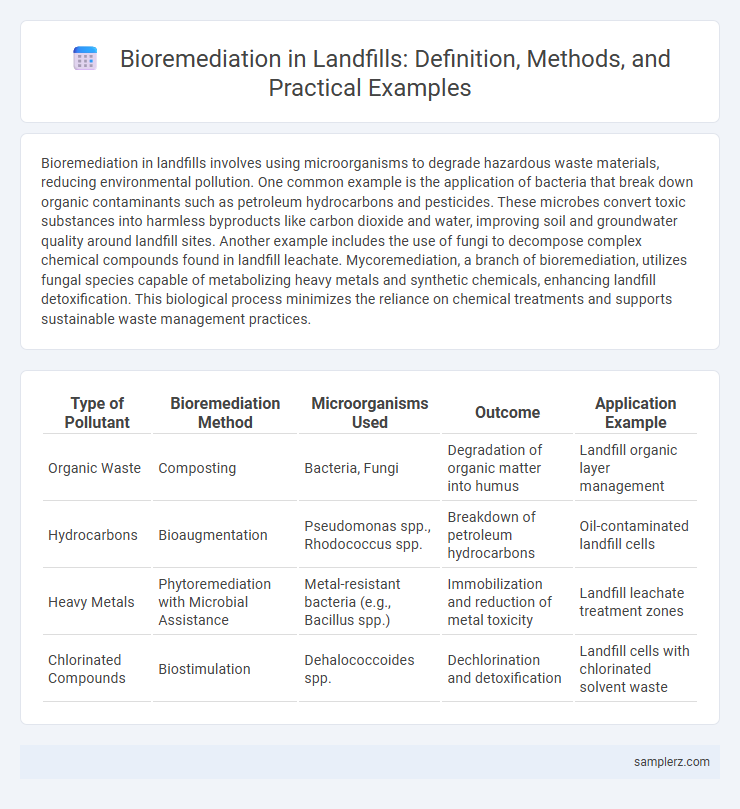Bioremediation in landfills involves using microorganisms to degrade hazardous waste materials, reducing environmental pollution. One common example is the application of bacteria that break down organic contaminants such as petroleum hydrocarbons and pesticides. These microbes convert toxic substances into harmless byproducts like carbon dioxide and water, improving soil and groundwater quality around landfill sites. Another example includes the use of fungi to decompose complex chemical compounds found in landfill leachate. Mycoremediation, a branch of bioremediation, utilizes fungal species capable of metabolizing heavy metals and synthetic chemicals, enhancing landfill detoxification. This biological process minimizes the reliance on chemical treatments and supports sustainable waste management practices.
Table of Comparison
| Type of Pollutant | Bioremediation Method | Microorganisms Used | Outcome | Application Example |
|---|---|---|---|---|
| Organic Waste | Composting | Bacteria, Fungi | Degradation of organic matter into humus | Landfill organic layer management |
| Hydrocarbons | Bioaugmentation | Pseudomonas spp., Rhodococcus spp. | Breakdown of petroleum hydrocarbons | Oil-contaminated landfill cells |
| Heavy Metals | Phytoremediation with Microbial Assistance | Metal-resistant bacteria (e.g., Bacillus spp.) | Immobilization and reduction of metal toxicity | Landfill leachate treatment zones |
| Chlorinated Compounds | Biostimulation | Dehalococcoides spp. | Dechlorination and detoxification | Landfill cells with chlorinated solvent waste |
Introduction to Bioremediation in Landfills
Bioremediation in landfills involves using microorganisms to degrade hazardous pollutants and organic waste, transforming them into less harmful substances. This process enhances waste stabilization, reduces leachate toxicity, and mitigates methane emissions, contributing to sustainable landfill management. Key techniques include bioaugmentation and biostimulation, which optimize microbial activity for efficient contaminant breakdown.
Key Microorganisms Used in Landfill Bioremediation
Key microorganisms used in landfill bioremediation include bacteria such as Pseudomonas, which degrade hydrocarbons and toxic organic compounds, and fungi like Phanerochaete chrysosporium that break down complex pollutants including heavy metals and chlorinated solvents. Methanogenic archaea play a vital role in organic waste decomposition by converting waste into methane in anaerobic landfill conditions. These microbial communities work synergistically to reduce waste toxicity and promote environmental restoration in landfill sites.
Anaerobic Decomposition Processes in Landfill Sites
Anaerobic decomposition processes in landfill sites involve microorganisms breaking down organic waste in oxygen-free conditions, producing methane and carbon dioxide as byproducts. Methanogenic bacteria play a crucial role in converting complex organic compounds into biogas, which can be captured and utilized as renewable energy. This bioremediation approach reduces landfill volume and greenhouse gas emissions while promoting sustainable waste management.
Bioaugmentation Strategies for Landfill Remediation
Bioaugmentation strategies in landfill remediation involve the introduction of specialized microbial consortia to accelerate the degradation of organic pollutants and reduce leachate toxicity. These targeted microorganisms enhance the metabolic pathways for breaking down complex compounds such as hydrocarbons, heavy metals, and chlorinated solvents commonly found in landfill sites. Studies demonstrate that bioaugmentation improves waste stabilization and minimizes environmental hazards by optimizing microbial diversity and activity in landfill ecosystems.
Phytoremediation Applications in Landfill Environments
Phytoremediation applications in landfill environments utilize specific plant species such as vetiver grass (Chrysopogon zizanioides) and poplar trees (Populus spp.) to absorb and degrade heavy metals and organic contaminants from soil and leachate. These plants enhance microbial activity in the rhizosphere, accelerating the breakdown of pollutants like polycyclic aromatic hydrocarbons and volatile organic compounds. Field studies demonstrate significant reductions in soil toxicity and improvement in groundwater quality through targeted phytoremediation strategies in landfill sites.
Case Studies: Successful Landfill Bioremediation Projects
Landfill bioremediation projects like the Fresh Kills Landfill in New York demonstrate effective decomposition of organic waste using microbial consortia, significantly reducing methane emissions and leachate toxicity. In Malaysia, the Bukit Tagar landfill employed bioaugmentation with specific bacteria strains, resulting in accelerated degradation of heavy metals and hydrocarbons. These case studies highlight the critical role of tailored microbial communities and environmental monitoring in achieving sustainable landfill remediation outcomes.
Mechanisms of Pollutant Breakdown in Landfill Bioremediation
Microorganisms in landfill bioremediation break down pollutants through enzymatic degradation, transforming hazardous organic compounds into harmless substances like carbon dioxide and water. Anaerobic bacteria play a key role by metabolizing complex hydrocarbons under oxygen-free conditions, producing methane and carbon dioxide as byproducts. This natural biochemical process reduces toxicity and stabilizes waste, enhancing landfill sustainability and minimizing environmental contamination.
Challenges and Limitations in Bioremediation of Landfill Waste
Bioremediation in landfill waste faces challenges such as the heterogeneity of pollutants and the presence of toxic compounds that inhibit microbial activity. Limited oxygen availability and fluctuating environmental conditions reduce the efficiency of biodegradation processes. Furthermore, the long-term stability of treated waste remains uncertain, posing risks of secondary contamination.
Environmental Benefits of Landfill Bioremediation
Landfill bioremediation significantly reduces harmful leachate contaminants by accelerating the degradation of organic waste through microbial activity, thereby protecting groundwater quality. This process lowers methane emissions, a potent greenhouse gas, mitigating climate change impacts associated with traditional landfill gas release. Enhanced stabilization of waste also minimizes land use requirements and promotes safer site reclamation for future environmental restoration projects.
Future Prospects for Bioremediation in Waste Management
Bioremediation in landfill management leverages microbial processes to degrade organic pollutants, offering a sustainable solution for waste treatment. Advances in genetic engineering and microbial consortia optimization promise enhanced degradation rates and adaptability to diverse contaminants. Future prospects include integrating bioremediation with smart monitoring systems for real-time assessment and improved efficiency in waste management operations.

example of bioremediation in landfill Infographic
 samplerz.com
samplerz.com